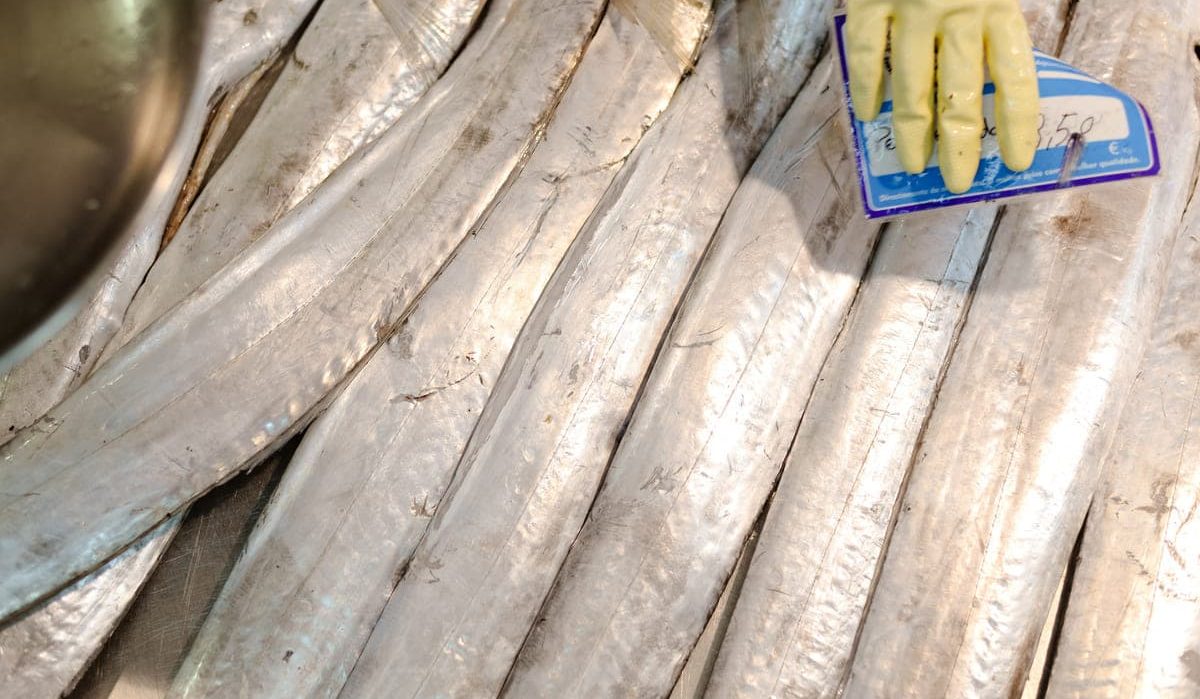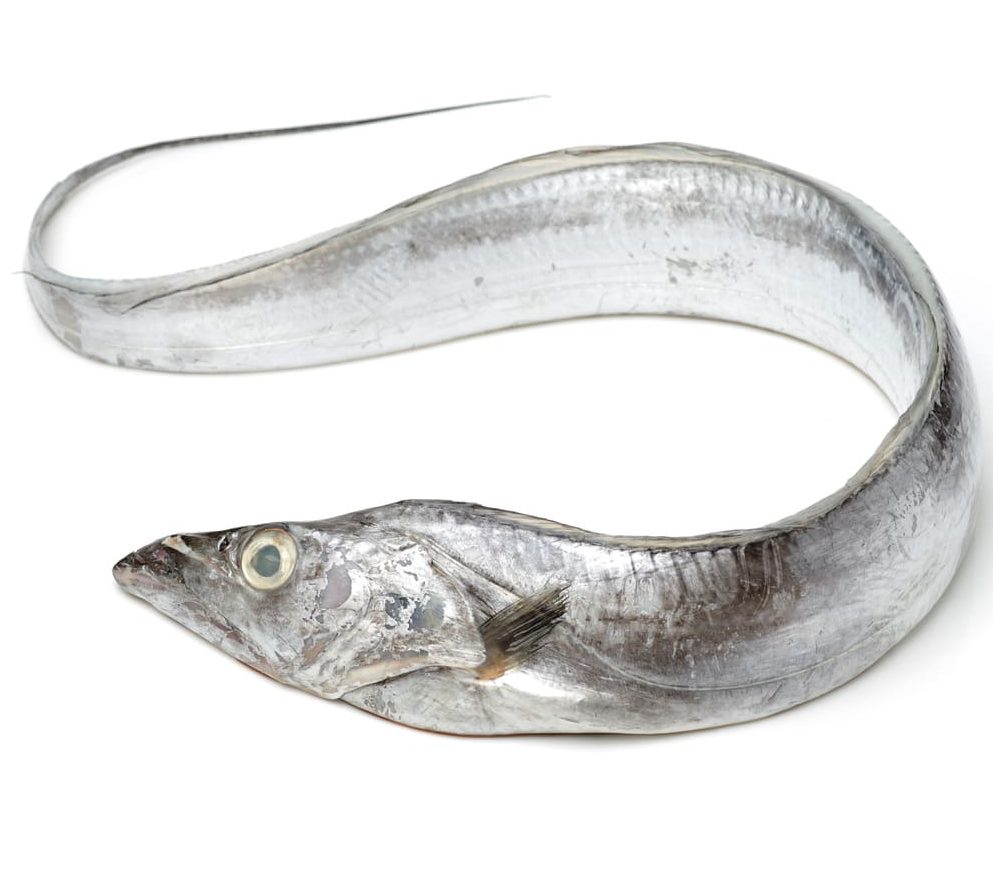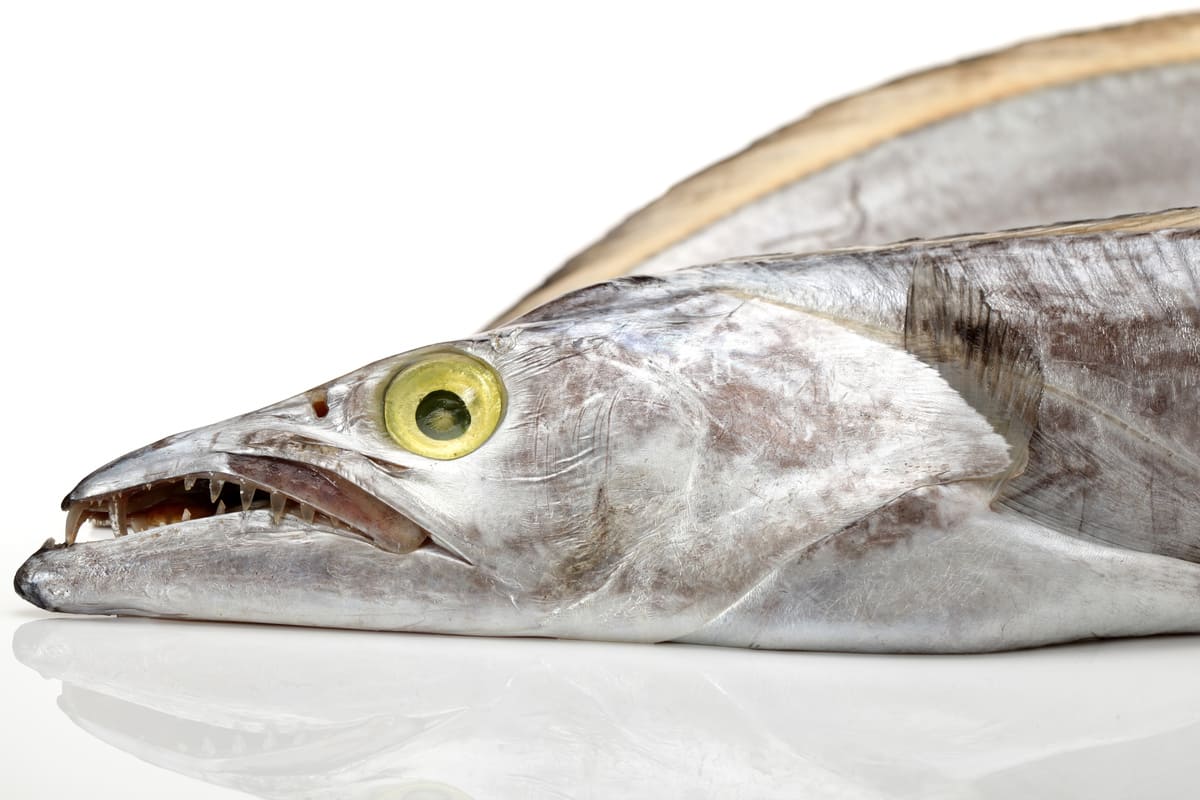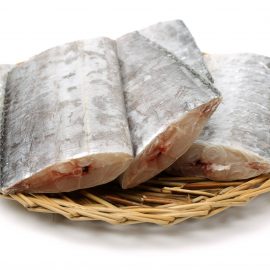
Introduction
Ribbon fish are fascinating deep-sea creatures that have long been admired for their graceful movements, striking appearance and vibrant colours. These aquatic creatures are captivating and mysterious, with dazzling iridescent scales and undulating ribbon-like bodies.
Healthy and delicious, ribbon fish is the ideal seafood choice, a prized food fish. Your family and friends will love this delicately flavoured and flaky fish. These are readily available in Asian markets, either whole or cut, on ice or in the freezer.
Description & Characteristics
The ribbon fish, a belt or cutlass fish, is an elongated and thin marine fish belonging to the Trachipteridae family.
Ribbon fish are distinctive due to their body shape, consisting of a long, slender body with a fin on each side and a small head often covered in scales. In terms of size, ribbon fish can range from 30 cm to 1.5 meters in length when fully grown.
The colouration of these fish varies by species and can range from light grey to bright silver depending on where they live in their natural habitat. Additionally, ribbonfish have large eyes, which help them see in low light conditions and sharp teeth that allow them to easily feed on small prey such as crustaceans and smaller fishes.
Additionally, they possess sharp spines on their gill covers, which may be used for defence against predators or deter potential threats from consuming them as prey items themselves.
Furthermore, these fish possess two barbels near their long mouth filled with sharp teeth, which assist them in finding food sources. Ribbonfish may also utilise bioluminescence to attract prey during nighttime feeding activities.

Etymology
The etymology of the ribbon fish is a fascinating topic for study and discovery. Although their name has been in use since the 17th century, its origin has remained a mystery. It is believed that the first use of the term ‘ribbon fish’ was by Dutch zoologists in 1684, who used it to describe a type of long-bodied, thin-finned fish they observed in the deep waters off Africa’s west coast. This may be because these fish have very narrow bodies, giving them the appearance of ribbons when seen from above.
The name ‘ribbon fish’ may also have been derived from their tendency to swim with their dorsal fin extended outwards, creating an image similar to that of a ribbon waved in the current.
Additionally, some species of ribbon fish are known for swimming near the ocean surface with their bodies arched upwards, making them look like a wave or a bow; hence, this behaviour may have inspired their common name.
Habitat And Distribution
Ribbon fish are found in the Atlantic, Pacific, and Indian Oceans. They inhabit a wide range of marine environments, from shallow coastal waters to deep ocean depths. In shallow waters near shore, ribbon fish usually form small schools that feed on planktonic organisms. These schools can often be observed in calm waters near the coast during daylight hours.
Further offshore and into deeper water, ribbon fish can also be found living among coral reefs, seagrass beds, and other benthic habitats. Ribbon fish populations also exist in more extreme environments, such as hydrothermal vents and cold-water coral reefs at depths greater than 1000 meters.
The distribution of ribbon fish is primarily determined by water temperature and salinity levels. They are most abundant in warm tropical waters with normal salinity levels but can also survive in colder waters with lower salinity levels. The migratory habits of ribbon fish vary depending on the species; some species remain within a single area throughout their lifespan, while others migrate seasonally or for spawning purposes.
Ribbon Fish’s Diet
Ribbon fish are predatory carnivores that feed on various prey items, such as crustaceans, molluscs, annelid worms and other small fishes. They can also be opportunistic scavengers and may even eat planktonic organisms.
Ribbon fish have been observed to forage for food in shallow waters during the day and deeper waters at night. Their diet may vary depending on the availability of prey in their habitat.
In addition to the prey mentioned above, ribbon fish have been known to hunt jellyfish, squid and octopus when available. Some species may also take advantage of dead or dying animals they come across while swimming, supplementing their diet with scavenged material. By utilising diverse strategies to find food, ribbon fish can ensure that they remain well-fed in all environments.
Life Cycle Of Ribbon Fish
The ribbon fish’s life cycle begins when eggs are laid in open water, usually in large schools. Once the eggs hatch, the juvenile ribbon fish swim near the ocean’s surface. As it matures, the ribbon fish will migrate to deeper waters and can often be found near coral reefs. The average lifespan of a ribbon fish is three to five years.
After hatching, it must bravely venture out into open waters and find its way through life. It must navigate deep areas and learn how to survive by feeding on small molluscs and crustaceans. Eventually, as it matures, it will reach deeper depths of understanding about its environment and gain strength from this knowledge.

Ribbon fish continue this struggle for survival until they reach their full potential before succumbing to natural causes after a few short years of life. With their unique shape and ability to adapt to different habitats, ribbon fish offer great opportunities for fisheries worldwide.
Ribbon Fish Fisheries
The ribbon fish is highly sought-after by fisheries around the world. Its long, slender profile and flavour have become a delicacy for many cultures.
Here are five ways that fisheries have impacted this species:
- Overfishing: Ribbon fish are often overfished due to their high demand in seafood markets. This has led to depleted populations in some areas and has resulted in a decrease in the availability of these fish.
- Bycatch: Ribbon fish are often caught unintentionally as bycatch when fishing for other species, such as tuna or mackerel. This can lead to a decrease in the population size of this species and can also cause mortality rates to rise due to mishandling or improper release methods.
- Illegal Fishing: Some countries have been known to engage in illegal fishing practices, which can involve using destructive gear or fishing without permits. This type of activity increases mortality rates and depletes populations of ribbon fish, making it difficult for them to recover from overfishing pressures and other human impacts.
- Habitat Loss: The destruction of coastal habitats, such as coral reefs, mangroves, and seagrass beds, can decimate ribbon fish populations by eliminating essential spawning grounds and nursery areas for juvenile ribbonfish.
- Pollution: Pollution from agricultural runoff and sewage discharge can adversely affect the health of marine ecosystems by reducing water quality, increasing disease levels, impairing reproduction and development, and contributing to habitat destruction. These effects can all lead to declines in ribbonfish numbers if left unchecked.
These human activities have significantly impacted ribbonfish populations worldwide, with many stocks now facing extinction due to unsustainable exploitation practices or habitat degradation from human activities like pollution or coastal development projects.
Therefore, it is crucial that fisheries be managed effectively for this species to survive and that regulations be put in place that limits overfishing or illegal activities related to harvesting them from their natural habitats. In addition, greater efforts must be made towards protecting fragile ecosystems from further harm so that future generations may continue enjoying their existence.
Sustainability
This fish has been fished for centuries, primarily for food and commercial consumption. In recent years, however, there have been growing concerns about the sustainability of ribbon fish populations due to overfishing and other human activities.
Ribbon fish are classified as a species with moderate vulnerability to fishing pressure and can potentially be overexploited if not managed responsibly. As such, it is essential that fisheries set responsible regulations and limits on the harvest and take measures to protect the species from becoming further depleted.
For example, many countries have implemented Total Allowable Catch (TAC) limits on harvesting ribbon fish, which are intended to ensure that catches remain within sustainable levels. Additionally, several countries have established Marine Protected Areas (MPAs) where fishing of ribbon fish is prohibited entirely to allow their numbers to recover in those areas.
The conservation status of ribbon fish varies by region due to differences in local fishery management practices. In some areas where regulations are strictly enforced, such as in parts of the Mediterranean Sea and off the coasts of Norway and Iceland, populations are generally considered healthy and abundant. However, in other regions with less stringent regulations or enforcement regimes, such as off the coasts of Morocco and Algeria, populations may be more depleted due to overfishing or other human activities like pollution or habitat destruction.
Ribbon Fish As Food
These fish have been an essential part of many cultures’ diets for centuries, with some populations relying heavily on them for sustenance.
Regarding food, ribbon fish has long been considered an excellent source of nutrition. It is high in protein and low in fat and calories, making it an ideal choice for those looking to maintain a healthy diet.
Additionally, ribbon fish has a mild flavour that makes it suitable for various dishes. It can be enjoyed steamed, fried or grilled and is commonly used in stir-fries and soups. It also works well with bold sauces such as teriyaki or barbecue sauce that help bring out its flavour. Ribbon fish is often served as sushi or sashimi due to its subtle flavour and firm texture.
Furthermore, since ribbon fish is lower in mercury than other seafood species, it makes for a safe and nutritious option when consumed regularly.
How To Prepare Ribbon Fish
Preparing this delicious seafood dish can be an art form, and when done correctly, it can make for a truly unforgettable meal.
Here is how to prepare ribbon fish for a delicious culinary experience:
1) Start by cleaning the fish with cold running water. Be sure to remove the tiny scales and any dirt or debris from the surface.
2) Once the fish has been cleaned, you need to fillet it carefully and remove any bones that may remain in the flesh.
3) Marinate the fish in a mixture of your favourite herbs and spices. This will allow the flavours to penetrate the flesh and make for a more flavorful finished product.
4) Finally, cook the fish on high heat in an open flame or an oven until it is fully cooked. This should take about 10 minutes, depending on the size and thickness of the fillets.
Preparing ribbon fish requires careful attention to detail but can be done relatively easily if instructions are followed closely. With its delicate flavour and flaky meat texture, ribbon fish makes a delightful addition to any seafood meal.

Best Side Dishes Paired With Ribbon Fish
Rice, potatoes, and vegetables are among the most popular side dishes paired with ribbon fish. Rice pairs particularly well with ribbon fish because its neutral taste allows the subtle flavours of the fish to shine through. Potatoes add a bit of crunch and complexity to the dish, while vegetables such as carrots or spinach provide additional flavour and colour. All these ingredients can be cooked together in one pot or served separately on individual plates.
Creative cooks may also opt for more innovative accompaniments such as couscous, quinoa, or other grains. Herbs like rosemary and thyme can also be added to enhance the dish’s flavour.
The key is to experiment and discover what combinations work best for you. Whether served with rice, potatoes, vegetables, or something else entirely – ribbon fish is sure to make for a delicious meal when paired with complementary sides.
Popular Ribbon Fish Recipes
They are popularly used in a variety of cuisines around the world due to their mild flavour and delicate texture. Common recipes include deep-frying, baking, sautéing, steaming, and grilling.
Deep frying is the most common method for preparing ribbon fish. When deep-fried, the skin can be left on or removed depending on the desired taste. The fish is then lightly dusted with flour before being fried in hot oil until it becomes golden brown and crispy.
Alternatively, baking ribbon fish produces a flaky texture when appropriately cooked at high temperatures. Ribbon fish can also be sautéed in butter or oil with other flavours, such as garlic and herbs, to create a delicious dish.
Steaming is another way to prepare this type of fish which helps retain its natural flavours while keeping its delicate texture intact. Grilled ribbon fish is also an option that can be served with various accompaniments, such as lemon wedges or tartar sauce.
For best results when cooking this type of fish, it is important to use fresh quality ingredients while following proper cooking techniques for optimal taste and texture. Seasoning ribbon fish with salt before cooking will enhance its flavour even further. With all these options available for preparing ribbon fish dishes, there’s sure to be something for everyone!
Comparison To Other Fish
Ribbon Fish is a unique, slender fish that has become increasingly popular as an ingredient in many dishes. It has a distinctive, delicate texture and flavour that distinguishes it from other types of seafood. Comparatively, ribbon fish has a milder taste than some relatives, such as mackerel or herring. Its light flavour pairs well with many sauces and other seasonings and ingredients.
The ribbonfish is an interesting species that stands out among other types of seafood due to its unique physical attributes and mild flavour profile. Whether you’re looking for a light meal or want something different for dinner, this versatile creature can spice up your plate!
History
Ribbon fish have a long history of being used for food and bait by fishermen. They are considered an essential part of many cultures’ diets, with some nations having specific traditions and rituals surrounding their consumption. For example, ribbon fish are often eaten raw as sushi or sashimi in Japan.
Ribbon fish have also been used for centuries for their medicinal properties. In traditional Chinese medicine, they are used to treat conditions such as hypertension and poor circulation, while in Ayurvedic medicine, they are said to improve digestion and reduce inflammation. In addition, ribbon fish oil is sometimes used topically to alleviate skin conditions like eczema due to its high omega-3 fatty acids.
Conclusion
The ribbon fish is a unique creature with a rich history and excellent nutritional value. Its bright colours and glittering scales make it an attractive dish for those looking for something different from their usual fare.
Finding ribbonfish in local markets may take effort but will ultimately prove rewarding for those seeking to reap the health benefits of eating this type of fish.
